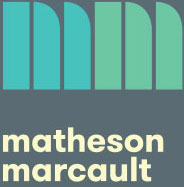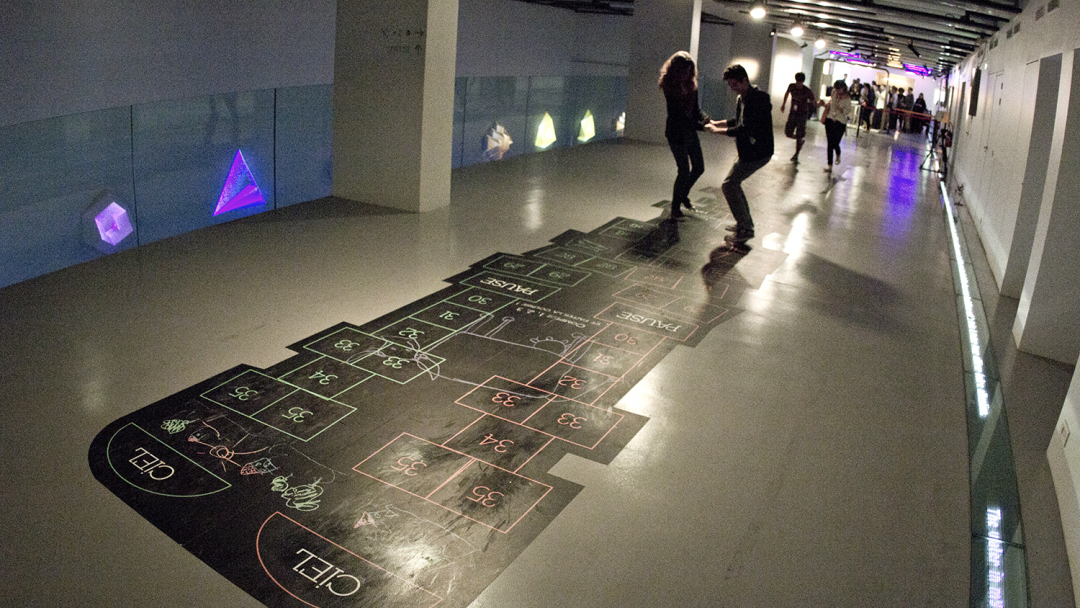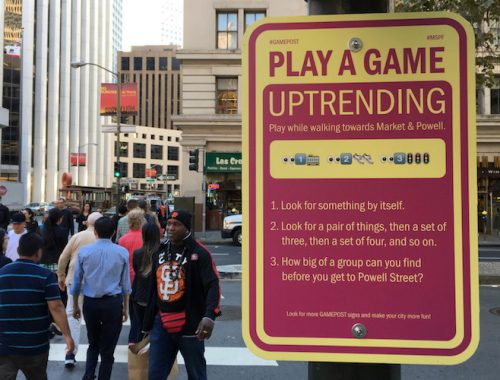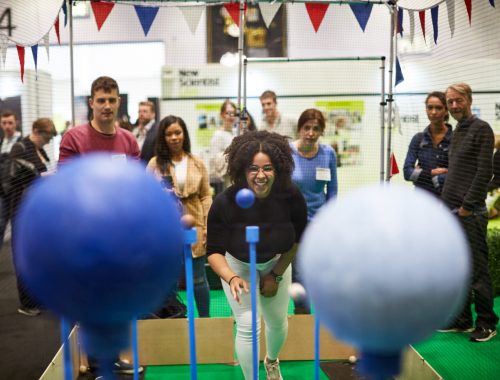As part of our research project for the King’s College London Arts and Humanities Festival, we’ve been interviewing different curators, designers, artists and architects about playful work for public space. This interview is with Heather Kelley, a game designer, digital artist, and media curator. She co-curated the groundbreaking 2012 exhibition Joue le jeu / Play Along at La Gaîté lyrique in Paris, France, and is co-founder of Kokoromi, an experimental game collective. She’s worked on console games, physical installations, VR and pretty much every area of game design.
One of her games, Trente Pas entre Terre et Ciel (shown above, and co-created with Oscar Barda of Them Games), is a two-player jumping game derived from hopscotch which we showed at Now Play This earlier this year, so we started out by talking to her about it. This is an edited extract from the full interview, which will be included in our report at the end of the research project.
US: So I read something in your talk about making games in institutional contexts (PDF). You mentioned there that when you were making Trente Pas you spent a load of time trying out different sizes of squares for people to hop in.
HEATHER: Mmm. So we wanted the squares to convey information inherently, so things like the direction the number was facing and things like that were important because they would say what way the player should be facing at that moment.
And they had to be also accommodating of different abilities and sizes of humans. If they were too small like a child-size square it’d be too small for an adult, and it might symbolise that it’s not for them. But if it’s too big then there’s the opposite problem. Kids would think it wasn’t for them. So it was finding this sweet spot between the size of the square and also the distance of the squares from each other, because you want them to be encouraging movement! You want people to hop! But you don’t want them to have to do the long jump to get there.
And also because it’s a game for two people the distance between squares was important because sometimes you wanted those people to have to pass by each other very close, and at other times you wanted them to be apart from each other – although they might be holding hands, physically connected but at arm’s length.
US: And do you remember how big they were, the squares? What is the perfect definitive researched tested proper hopscotch size?
HEATHER: I do not remember! It wouldn’t be impossible to find the actual file… theoretically the information about that is somewhere.
US: Though I suppose it might differ for different courses! Trente Pas is such a long course so I suppose you don’t want it to be too challenging, or people might get exhausted? But it does seem like if you’ve found out the best size to iterate from…
HEATHER: We did have a sense of how big was good. And to account for the exhaustion factor we had “pause points” so you only had to do one style of hopping, roughly the equivalent of a normal hopscotch length. Then you’d pause, read the next instruction, and do something else. So hopefully we wouldn’t totally wear people out.
But in conjunction with the official installation inside the Gaîté we did a guerilla campaign of hopscotch on the streets, and we did a lot of stencilling for that. The game you had at Now Play This is much more akin to the ones we did outside the Gaîté, which used the same sort of spray chalk.
The ones I thought got the best response were some that were on sidewalks that were pretty narrow, like one that was close to the Musée des Arts et Métiers. Because it was right there on the sidewalk, we did notice that people who walked by – children especially – were interacting as they went along.
The ones that looked closer to an iconic hopscotch got a little more interaction, as well as the ones that were directly on a path that you couldn’t really avoid.
US: You did a different project in Witten a couple of years ago, the 72 Hour Urban Action project with Invisible Playground, and your team made a maze, is that right? [72 Hour Interactions was a project where different groups made playful physical interventions and installations in Witten in Germany over a 72-hour period].
HEATHER: Huh yeah!
That was a super-interesting project that I don’t get to talk about often. Our first concept was for a physical, traditional maze made out of plywood but with adjustable parts so players could change the maze for other people. And the other designer on the team, Greg Foster, who’s a member of The Larks, the theatre group based in Manchester, got the idea to do these more frond-like things instead of plywood, hanging down, and you move right through them.
We hung icons among these fronds so that if you just wandered around enough you’d locate them, and they formed a kind-of invitation to explore… it was called the Verlustbüro, the Lost and Found Office, so you’d get lost and then you’d find things.
I liked that as well because we were trying to encourage certain behaviours, and these hanging objects were kind-of like a Christmas ornament, these hanging wooden decorated things.
It was to encourage people to explore and not to just blow right through it. It was a really small space but really disorienting. And there were a few different exits – one way in, a number of different ways out.
US: And it sounds – I talked to Sebastian a bit about this whole project [from Invisible Playground, one of the organisers] and it sounds like the takeup of all the different projects that different groups made was pretty great?
HEATHER: Meaning what, that the citizens of Witten… yeah, they really liked our piece which was super gratifying. And it was really great working with people that stopped by while we were building it. It was built with the community in mind and with people randomly dropping by and asking what we were doing and then hanging out because it was a pleasant place to be and they were there already walking their dog…
I think one of my most profound moments as a game designer ever was… well after we built it, of course we were all completely sleep-deprived and exhausted but happy that we’d got it done, and it was the last day, the open day for the city residents to come and check out all the projects. A woman came by in a mechanised wheelchair who was profoundly disabled. She was there with a friend and through her friend she asked if there was a way she could participate. And the architects on the team had made it so that she could – it wasn’t perfect because the ground was uneven but they’d definitely made it wide enough that the wheelchair could fit through, and she could go through and experience it.
With a lot of the other games made during that project that wasn’t possible because they were about climbing up on things or moving around a lot, and I just remember when she was interested and hovering around the edge, to be able to say “yeah you can totally do this, this is for you” – it’s pretty cliched but that was really powerful for me, that we’d made something that was that flexible and enjoyable for so many people.
US: A lot of urban play does tend to be very focused on agility, doesn’t it, being able to jump around and run and climb.
HEATHER: Which is kind of one of my hobby horses for street games and physical games. That was still true with Trente Pas when we made it, because Oscar was bringing the physical agility part and I was bringing “hey, I have a busted knee, I’m not going to make something that I can’t even enjoy”. Hopefully I would have had that thought before I had a busted knee, hopefully it wasn’t only because of that factor! But I go to street game festivals and sometimes it’s all: oh, we’re gonna play Turtle Wushu and Ninja and things that really depend on physically agile movement. Chasing! I fucking hate chasing games.
So any time I can make something that’s participatory and physical and spatial and environmental that draws on other interactions…
US: There are other ways of being in a space?
HEATHER: And interacting with people. Which was another thing about being in the Verlüstburo – it was really like being in a big fog. It had a nice sound, that was one thing, this fwfwwwfwfwfw whispering, and maybe you could hear other people moving. And sometimes you’d come across other people – you’d part the fronds and there they are.
And it was the summer and it was breezy so there was an almost leafy sound to the fronds, just blowing in the wind.




